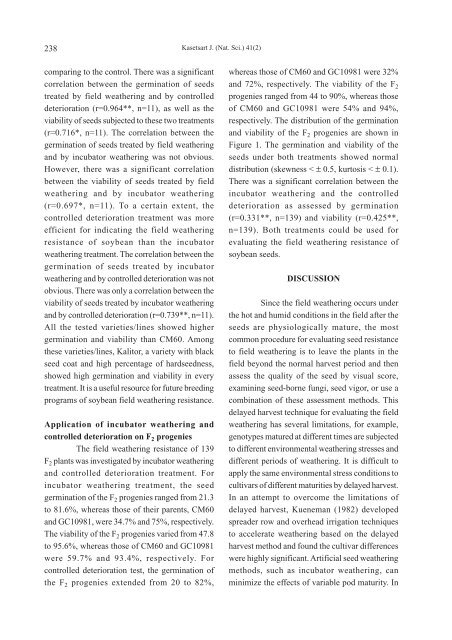April - June 2007 - Kasetsart University
April - June 2007 - Kasetsart University
April - June 2007 - Kasetsart University
You also want an ePaper? Increase the reach of your titles
YUMPU automatically turns print PDFs into web optimized ePapers that Google loves.
238<br />
comparing to the control. There was a significant<br />
correlation between the germination of seeds<br />
treated by field weathering and by controlled<br />
deterioration (r=0.964**, n=11), as well as the<br />
viability of seeds subjected to these two treatments<br />
(r=0.716*, n=11). The correlation between the<br />
germination of seeds treated by field weathering<br />
and by incubator weathering was not obvious.<br />
However, there was a significant correlation<br />
between the viability of seeds treated by field<br />
weathering and by incubator weathering<br />
(r=0.697*, n=11). To a certain extent, the<br />
controlled deterioration treatment was more<br />
efficient for indicating the field weathering<br />
resistance of soybean than the incubator<br />
weathering treatment. The correlation between the<br />
germination of seeds treated by incubator<br />
weathering and by controlled deterioration was not<br />
obvious. There was only a correlation between the<br />
viability of seeds treated by incubator weathering<br />
and by controlled deterioration (r=0.739**, n=11).<br />
All the tested varieties/lines showed higher<br />
germination and viability than CM60. Among<br />
these varieties/lines, Kalitor, a variety with black<br />
seed coat and high percentage of hardseedness,<br />
showed high germination and viability in every<br />
treatment. It is a useful resource for future breeding<br />
programs of soybean field weathering resistance.<br />
Application of incubator weathering and<br />
controlled deterioration on F 2 progenies<br />
The field weathering resistance of 139<br />
F 2 plants was investigated by incubator weathering<br />
and controlled deterioration treatment. For<br />
incubator weathering treatment, the seed<br />
germination of the F 2 progenies ranged from 21.3<br />
to 81.6%, whereas those of their parents, CM60<br />
and GC10981, were 34.7% and 75%, respectively.<br />
The viability of the F 2 progenies varied from 47.8<br />
to 95.6%, whereas those of CM60 and GC10981<br />
were 59.7% and 93.4%, respectively. For<br />
controlled deterioration test, the germination of<br />
the F 2 progenies extended from 20 to 82%,<br />
<strong>Kasetsart</strong> J. (Nat. Sci.) 41(2)<br />
whereas those of CM60 and GC10981 were 32%<br />
and 72%, respectively. The viability of the F 2<br />
progenies ranged from 44 to 90%, whereas those<br />
of CM60 and GC10981 were 54% and 94%,<br />
respectively. The distribution of the germination<br />
and viability of the F 2 progenies are shown in<br />
Figure 1. The germination and viability of the<br />
seeds under both treatments showed normal<br />
distribution (skewness < ± 0.5, kurtosis < ± 0.1).<br />
There was a significant correlation between the<br />
incubator weathering and the controlled<br />
deterioration as assessed by germination<br />
(r=0.331**, n=139) and viability (r=0.425**,<br />
n=139). Both treatments could be used for<br />
evaluating the field weathering resistance of<br />
soybean seeds.<br />
DISCUSSION<br />
Since the field weathering occurs under<br />
the hot and humid conditions in the field after the<br />
seeds are physiologically mature, the most<br />
common procedure for evaluating seed resistance<br />
to field weathering is to leave the plants in the<br />
field beyond the normal harvest period and then<br />
assess the quality of the seed by visual score,<br />
examining seed-borne fungi, seed vigor, or use a<br />
combination of these assessment methods. This<br />
delayed harvest technique for evaluating the field<br />
weathering has several limitations, for example,<br />
genotypes matured at different times are subjected<br />
to different environmental weathering stresses and<br />
different periods of weathering. It is difficult to<br />
apply the same environmental stress conditions to<br />
cultivars of different maturities by delayed harvest.<br />
In an attempt to overcome the limitations of<br />
delayed harvest, Kueneman (1982) developed<br />
spreader row and overhead irrigation techniques<br />
to accelerate weathering based on the delayed<br />
harvest method and found the cultivar differences<br />
were highly significant. Artificial seed weathering<br />
methods, such as incubator weathering, can<br />
minimize the effects of variable pod maturity. In
















